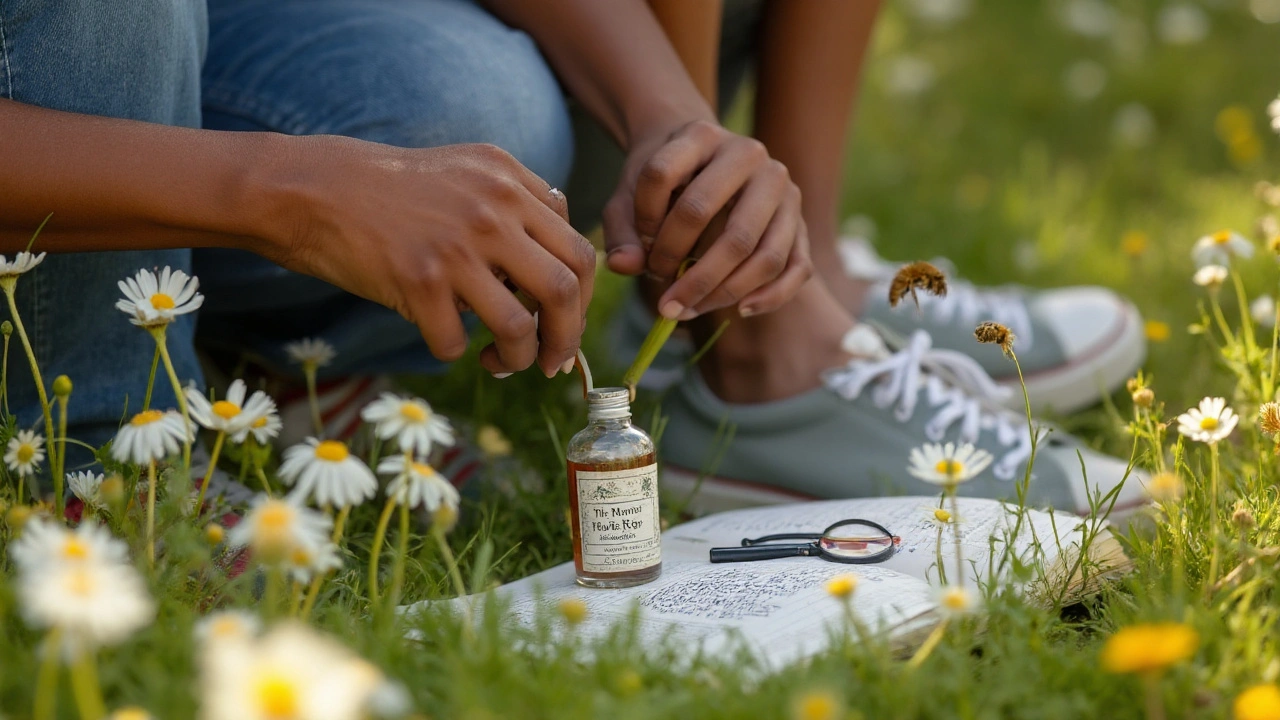TL;DR
- Wild daisy (Bellis perennis) shows antioxidant and anti-inflammatory activity in lab and animal studies, but there are no solid human trials for oral use.
- If you’re chasing big, fast results, this isn’t a miracle pill. It’s a gentle herb that might complement a balanced routine.
- Safety: avoid if you’re allergic to ragweed/asters; skip during pregnancy/breastfeeding; watch for GI upset and possible interactions with anticoagulants and diuretics.
- Typical use: teas and tinctures are more traditional; capsule doses vary widely with no official standard. Start low, go slow.
- Buying tip: choose products with third-party testing (USP, NSF, ConsumerLab), correct botanical name (Bellis perennis), and transparent extract ratios.
What Wild Daisy Actually Is (and What People Mean When They Say It)
You see “Revolutionize Your Health with Wild Daisy” and wonder if you’ve missed the next big thing. Here’s the grounded truth. Wild daisy usually refers to Bellis perennis-the small white lawn daisy you’ve seen since childhood. It’s edible, mildly bitter, and used in traditional European herbalism for gentle support. It’s not the same as chamomile (Matricaria chamomilla), feverfew (Tanacetum parthenium), or echinacea (Echinacea purpurea), even though they’re all part of the Asteraceae family and share a daisy-like look.
Why the confusion? Common names. “Daisy” is a look more than a species. That’s why the label matters. When you shop, check the Latin name: Bellis perennis. If the label only says “wild daisy” or uses a blend, you can’t be sure what’s inside.
Bottom line: this herb has a long folk history, but it’s not well-studied in modern clinical trials. Think of it as a gentle botanical, not a blockbuster drug.
Potential Benefits: What the Science Actually Says
Let’s set expectations with what we know in 2025. Most of the modern evidence for Bellis perennis is preclinical-test-tube and animal studies. Those can hint at mechanisms, but they don’t guarantee benefits in people. Here’s the realistic picture.
- Antioxidant and anti-inflammatory signals: Extracts of Bellis perennis contain flavonoids (like apigenin and luteolin glycosides), phenolic acids (caffeic, chlorogenic), and triterpenoid saponins. In lab settings, these compounds can reduce markers linked to oxidative stress and inflammation. That may explain its traditional use for minor aches or skin support.
- Skin and wound support (mostly topical/traditional): Historically, daisy poultices and salves were used for bruises and minor wounds. Modern herbalists still reach for it topically. Oral use for skin benefits hasn’t been proven in rigorous human trials.
- Digestive comfort (traditional use): As a mild bitter herb, daisy tea has been used before meals to nudge digestion. Some people notice less bloating. Evidence here is experiential and historical, not clinical-grade.
- Mild diuretic effect (animal data): Some studies in rodents suggest increased urine output. That’s not the same as a clinically meaningful effect in humans, and it could interact with diuretics if you take them.
What’s missing? Randomized, placebo-controlled human trials on oral wild daisy for common goals like joint comfort, skin health, or digestion. As of September 2025, there aren’t robust trials showing clear, repeatable benefits in healthy adults. So the best framing is: potentially supportive, low-intensity, and unlikely to “revolutionize” your health on its own.
Credibility notes you can verify: Bellis perennis lacks a formal EU herbal monograph as a licensed herbal medicinal product, which usually signals limited standardized clinical evidence. Cross-reactivity caution within the Asteraceae family is recognized in allergy practice parameters. These aren’t judgments; they’re guardrails for realistic expectations and safe use.
| Health Goal | Human Evidence | Lab/Animal Evidence | Confidence | Typical Product Forms | Notes |
|---|---|---|---|---|---|
| General inflammation | No quality RCTs | Yes (anti-inflammatory signals) | Low | Tea, tincture, capsules | Mechanistic plausibility; clinical effect unknown |
| Skin/wound support | Topical tradition; oral data lacking | Yes | Low-Moderate (topical) | Topical salve, tea compress | Consider topical before oral for this goal |
| Digestive comfort | Anecdotal/traditional | Limited | Low | Tea pre-meal | Acts as a mild bitter |
| Diuretic effect | No human trials | Yes (rodent) | Low | Tea, tincture | Be careful if on diuretics |
Safety, Side Effects, and Who Should Skip It
Most healthy adults tolerate small amounts of wild daisy as a tea or food garnish. Still, plants in the Asteraceae family can bite back if you’re sensitive. Here’s the short list to make this practical.
- Allergy watch: If you’re allergic to ragweed, chrysanthemums, marigolds, or chamomile, be careful. Cross-reactivity happens within the Asteraceae family. If you’ve had hives, wheezing, or swelling from similar plants, skip this or talk to your allergist first.
- Pregnancy and breastfeeding: There’s not enough safety data for oral use. The standard advice from clinicians and herbal references is to avoid during pregnancy and lactation.
- Kids: No established dosing for children. Avoid unless advised by a pediatric professional who knows herbs.
- Medication interactions (theory-based): Herbs rich in polyphenols and saponins can, in theory, affect how drugs are absorbed or metabolized. Two areas of caution: anticoagulants/antiplatelets (bleeding risk) and diuretics (additive fluid loss). If you take warfarin, DOACs, aspirin, thiazides, or loop diuretics, check with your clinician.
- Common side effects: mild stomach upset, nausea, or loose stools when starting or with larger doses. Rarely, allergic reactions (rash, itching, swelling). Stop and seek care if you notice trouble breathing, swelling of lips/tongue, or severe hives.
- Liver/kidney: No signals of toxicity at typical culinary amounts, but long-term, concentrated extracts haven’t been tested well in humans. If you have liver or kidney disease, play it safe and avoid unless your care team says otherwise.
Practical rules of thumb:
- Start low, go slow: try a weak tea or half-dose tincture for a few days.
- Change one thing at a time: don’t stack multiple new supplements in the same week-you won’t know what caused what.
- Two-week checkpoint: if you notice no benefit after two weeks at a reasonable dose, it’s fair to stop.
How to Use It: Forms, Doses, and Timing
There’s no official, universally accepted dose for oral Bellis perennis. Traditional ranges and modern products vary a lot. Here’s how people typically approach it-then tailor based on your response and medical context.
- Tea (infusion): 1-2 teaspoons of dried aerial parts (about 1.5-3 g) per 8 oz hot water; steep 10-15 minutes; 1-3 times daily. Start with one cup.
- Tincture (1:5 in 40-50% alcohol): 1-2 mL up to three times daily. Start with 0.5-1 mL once daily for a few days.
- Liquid glycerite: usually similar volume to tincture; check the label since glycerites vary in strength.
- Capsules: wildly inconsistent between brands. You’ll see 250-500 mg dried herb per capsule, or standardized extracts with ratios like 4:1. When in doubt, start with the lowest serving on the label and reassess after 7-14 days.
Timing tips:
- For digestion: tea 15-30 minutes before meals can make sense, given the mild bitter nature.
- For general wellness: pick a time you’ll remember daily-morning or early afternoon. Avoid taking right before bed if you’re sensitive to any mild diuretic effect.
- Hydration matters: if you notice more frequent urination, increase water intake, especially in hot weather or with exercise.
Stacking or combos:
- Skin support: consider topical products with daisy alongside oral tea. Topical is where most traditional use sits.
- Digestion: pair with ginger tea or chamomile in the evening if you tolerate Asteraceae, but build up one herb at a time.
- Inflammation support: if you need stronger evidence, curcumin (with piperine), Boswellia, or standardized chamomile have more human data than Bellis perennis. Always check interactions.

How to Buy a Legit Wild Daisy Supplement + Smarter Alternatives
If you decide to try it, buying well is half the game. Here’s how to avoid weak formulas and mislabeled products.
- Botanical identity first: label should read Bellis perennis (aerial parts), including the plant part used (flower/leaf) and the extract ratio or standardization if applicable.
- Third-party testing: look for USP Verified, NSF Certified, or a recent Certificate of Analysis by an ISO 17025-accredited lab. These seals don’t prove efficacy, but they do signal you’re getting what the label says without heavy metals or contaminants.
- Transparent dosing: the label should list mg per serving and, if an extract, the ratio (e.g., 4:1) or marker compounds. “Proprietary blend” without amounts is a red flag.
- Short ingredient lists: skip products overloaded with filler herbs and pixie-dust amounts of daisy.
- Allergen disclosure: “Contains Asteraceae” is not always printed, so assume cross-reactivity risk if you’re sensitive.
Decision guide-Should you try it?
- Yes, worth a small trial: you enjoy gentle herbal teas, want a mild digestive bitter or a calming ritual, and you don’t have Asteraceae allergies or interacting meds.
- Maybe, but consider alternatives: you want measurable anti-inflammatory effects or sleep benefits. Look at chamomile (sleep/anxiety), curcumin (joint comfort), or Boswellia (joint comfort) with better human data.
- No: you’re pregnant, breastfeeding, allergic to ragweed/asters, on anticoagulants or diuretics, or you expect fast, dramatic results.
| Use Case | Wild Daisy (Bellis perennis) | Chamomile (Matricaria chamomilla) | Curcumin (Turmeric extract) | Boswellia (Boswellia serrata) |
|---|---|---|---|---|
| Evidence for calm/sleep | Very limited | Moderate human data | Limited for sleep | Limited for sleep |
| Evidence for joint comfort | Preclinical only | Limited human data | Moderate human data | Moderate human data |
| Digestive comfort | Traditional use | Traditional + some data | Mixed; more for inflammation | Not primary |
| Typical safety profile | Likely safe in small amounts; allergy risk (Asteraceae) | Generally safe; allergy risk (Asteraceae) | Generally safe; watch anticoagulants | Generally safe; watch GI upset |
One more tip: if your goals are skin-related, start with topical products that clearly list Bellis perennis along with soothing allies like calendula. You’ll probably notice effects faster on the skin than from a capsule.
Quick Checklists, Pro Tips, and a Reality Reset
Product label checklist:
- Latin name: Bellis perennis (not just “wild daisy”)
- Plant part: flowers/leaf or “aerial parts” specified
- Dose clarity: mg per serving and extract ratio (if applicable)
- Quality seals: USP, NSF, or third-party lab COA
- Allergen info and cautions listed
Safety checklist before you start:
- I don’t have ragweed/Asteraceae allergies
- I’m not pregnant or breastfeeding
- My meds don’t include anticoagulants, antiplatelets, or diuretics-or I’ve cleared it with my clinician
- I’ll test a low dose for 3-5 days before increasing
- I’ll stop if I get hives, wheezing, facial swelling, or persistent GI upset
Pro tips to actually get value:
- Tea first: it’s cheaper, controllable, and you’ll notice quickly if your body likes it.
- Pair with habits: a walk after dinner and earlier screens-off will do more for your inflammation and sleep than any one herb.
- Journal a baseline: rate your symptom (bloating, joint stiffness, skin redness) 0-10, then check again after 14 days. If no change, cut it.
Reality reset: words like “revolutionize” are great for ads, not for your body. Bellis perennis can be a pleasant, gentle add-on. The heavy lifting for health still comes from sleep, protein and fiber, movement, and managing stress and blood sugar.
Evidence and sourcing notes to keep you grounded:
- Clinical trials: as of September 2025, there are no high-quality randomized trials showing oral wild daisy improves common outcomes in healthy adults.
- Regulatory snapshots: there’s no European Medicines Agency herbal monograph for Bellis perennis as a traditional herbal medicinal product. That usually means limited standardized clinical evidence.
- Allergy context: cross-reactivity within Asteraceae is recognized in allergy guidelines and case reports; if you’ve reacted to ragweed/chamomile, treat wild daisy with caution.
Mini‑FAQ
Does wild daisy work for inflammation?
There’s lab and animal evidence of anti-inflammatory activity, but no solid human trials. If you need measurable relief, look at better-studied options like curcumin or Boswellia, and talk to your clinician.
Can I take it with chamomile?
Many people do, especially as a tea blend. If you have Asteraceae allergies, blending doubles your risk. Try each herb separately first to test tolerance.
Is it safe in pregnancy?
There isn’t enough data for oral use. The conservative call is to avoid during pregnancy and breastfeeding.
How long until I notice anything?
If it helps, you might notice mild digestive or calming effects within a week. If there’s no change after 2 weeks, it’s reasonable to stop.
Tea or capsules-which is better?
Tea gives you control and a gentler dose. Capsules are convenient but vary a lot in potency. Start with tea unless you need portability.
Can kids take wild daisy?
There’s no established pediatric dosing. Avoid unless a pediatric clinician who understands herbs guides you.
Is wild daisy the same as chamomile?
No. They’re different plants in the same family. Chamomile has more human research behind it.
Next Steps and Troubleshooting
If you’re curious and healthy:
- Run a quick safety check: allergies, meds, pregnancy status.
- Buy a product that lists Bellis perennis with third-party testing.
- Start with tea once daily for 3-5 days. Note any changes in digestion or skin calmness.
- If tolerated, increase to twice daily for up to 2 weeks and reassess. No benefit? Stop.
If you’re on medications or have conditions:
- Talk to your clinician or pharmacist first, especially with blood thinners, blood pressure meds, or diuretics.
- If cleared, start at half the labeled dose and schedule a check-in after 1-2 weeks.
If you notice side effects:
- GI upset: cut the dose in half or switch to tea. Take with a small snack.
- Itching, hives, swelling, breathing issues: stop immediately and seek care.
- Lightheadedness or unusual fatigue: hydrate, pause the herb, and review other changes in your routine.
If your main goal is inflammation, sleep, or skin and you want stronger data:
- Inflammation: consider curcumin standardized to 95% curcuminoids with piperine (if your clinician approves), or Boswellia standardized to AKBA.
- Sleep/calm: chamomile tea, magnesium glycinate, or cognitive wind-down routines (breathwork, dim lights, earlier screens-off).
- Skin: try topical daisy/calendula blends first; add oral omega-3s if appropriate.
Final thought: You don’t need to believe in magic herbs to enjoy simple, gentle support. Use wild daisy like a nudge, not a crutch. Prioritize the boring basics that move the needle most, and you’ll get farther-supplement or not.
Important note on labeling: Make sure the product states Bellis perennis. Brands sometimes market a wild daisy supplement while using blends or different asters. When in doubt, ask the company for a recent Certificate of Analysis from an accredited lab.









19 Comments
Jessica Simpson
Sep 4 2025I love how this guide pulls together the science and the folklore-makes the wild daisy feel like an old friend you can actually trust. The tip about checking the Latin name is spot on, because a lot of products hide behind a generic “wild daisy” label. Just a heads‑up: I’ve seen a couple of brands miss‑spell Bellis perennis as “Belles perennis”, so keep an eye out. If you’re from Canada, the health‑claims regulations are pretty strict, so the third‑party testing seals are especially useful.
Ryan Smith
Sep 11 2025Yeah, because the government’s definitely letting secret labs hide nano‑daisies in our tea.
John Carruth
Sep 18 2025I’ve read through the entire post and I have to say, the author did a commendable job of balancing optimism with scientific humility.
First, the historical context of Bellis perennis as a gentle bitter aligns well with traditional European herbal practices.
Second, the clear distinction between topical and oral applications helps readers avoid the common pitfall of assuming a cream’s benefits will translate to a capsule.
Third, the safety checklist is thorough, especially the reminder about Asteraceae cross‑reactivity, which many supplement guides gloss over.
Fourth, the dosage suggestions for tea-1‑2 teaspoons per 8 oz-are practical and easy to adopt for most people.
Fifth, the discussion of potential drug interactions, particularly with anticoagulants and diuretics, shows a responsible approach to patient safety.
Sixth, the recommendation to start low and go slow mirrors the classic principle of hormesis in phytotherapy.
Seventh, the buying guide’s emphasis on third‑party testing and accurate botanical labeling is essential in a market flooded with proprietary blends.
Eighth, the comparison table that places wild daisy side‑by‑side with chamomile, curcumin, and Boswellia gives a quick visual reference for readers weighing options.
Ninth, the author’s honesty about the lack of high‑quality human RCTs prevents the hype that often accompanies herbal marketing.
Tenth, the suggestion to keep a symptom journal for two weeks adds a measurable component that many people overlook.
Eleventh, the mention of using wild daisy topically for skin issues acknowledges the stronger evidence base for external use.
Twelfth, the note that long‑term concentrated extracts have not been rigorously tested reminds us that natural does not automatically equal safe at any dose.
Thirteenth, the advice to avoid the supplement during pregnancy and breastfeeding aligns with standard precautionary principles in herbal medicine.
Fourteenth, the overall tone remains balanced, neither dismissing the herb’s potential nor promising miracle cures.
Finally, readers should feel empowered to experiment with a modest tea regimen while staying vigilant about allergies and interactions, and that’s the sweet spot the article hits.
Melodi Young
Sep 24 2025This article hits most of the right notes, but I have to call out the “folklore” section as a bit of a lazy shortcut. Sure, the old‑world uses of daisy are interesting, but we need more than anecdotes to justify a supplement. Also, the dosage range for capsules is too vague – “250‑500 mg” could mean anything from a weak infusion to a potent extract. And let’s be honest: the market is flooded with “proprietary blends” that hide the real amount of Bellis perennis. If you’re paying premium prices, demand transparency. Otherwise you’re just buying a fancy tea leaf.
Tanna Dunlap
Oct 1 2025While the author tries to be balanced, the piece still romanticizes an herb that lacks solid human data. It’s morally questionable to promote a supplement without clear efficacy, especially when vulnerable readers might spend money hoping for miracle results. The safety checklist is thorough, yet the tone downplays the seriousness of Asteraceae allergies – a single rash could be life‑threatening for some. Moreover, the recommendation to “try it for two weeks” feels like a marketing ploy rather than a scientifically‑backed protocol. Readers deserve a stark warning: without robust trials, any claimed benefits remain speculative at best.
Troy Freund
Oct 8 2025Fair points from the previous comment – I’d add that the chill vibe of having a tea in the evening can be beneficial on its own, regardless of the herb’s pharmacology. A simple ritual of sipping warm water with a pinch of daisy might help signal relaxation, similar to the way a bedtime routine works. It’s less about the active compounds and more about the mental cue. Keep the expectations modest and enjoy the moment.
Mauricio Banvard
Oct 15 2025Let’s not forget that the big pharma watchdogs are quietly funding research on “natural” anti‑inflammatory agents, and wild daisy could be a front‑line target. The color‑rich flavonoids in Bellis perennis might be masking more than we know – perhaps even nano‑particles that interact with our microbiome in ways science hasn’t caught up to yet. So, while the post says “no solid human trials”, stay woke – the data could be hidden in obscure journals. Keep your eyes peeled and your tea cup full.
Paul Hughes
Oct 21 2025Interesting take! 🌿 I agree that keeping an open mind is key. While I’m not buying into conspiracies, I do think it’s wise to stay curious and check any new studies that pop up. If you do decide to try the tea, maybe start with a half‑cup and see how it feels. 😊
Mary Latham
Oct 28 2025Okay, but let’s be real – the hype around wild daisy is just another trend that folks are jumping on without any real proof. I’ve seen a lot of “miracle” herbs get overhyped, and this is no different. The article tries to sound balanced, but it’s still pushing a product that has barely any RCTs behind it. If you’re looking for something that actually works, stick with the classics that have solid data.
Marie Green
Nov 4 2025Totally get where you’re coming from – it can feel like a marketing spin. Still, the safety tips are solid and the tea could be a nice gentle addition. Just keep expectations low and watch for any reactions.
TOM PAUL
Nov 11 2025Curious about the exact compounds in Bellis perennis? I’d love to see a mass‑spectrometry profile of a standardised extract. Also, does anyone know if the plant’s phenolics vary with soil type? Those details would help us understand variability in product quality.
Ash Charles
Nov 17 2025Listen, you’re missing the point. Push forward, grab a bottle, and start with a modest dose. If you’re serious about health, you need to act, not just talk. Let’s see some real commitment here.
Sorcha Knight
Nov 24 2025OMG, I tried the wild daisy tea and felt like a magical forest fairy for like, an hour! ✨ The aroma was sooo calming, I could literally hear the birds chirping. Seriously, if you haven’t given it a go, you’re missing out on the ultimate chill‑vibe experience. 😍
Emily Stangel
Dec 1 2025While the enthusiastic anecdote reflects genuine personal experience, it is essential to contextualize such subjective sensations within the framework of evidence‑based practice. The sensory perception of aroma and the associated relaxation response may derive from the pleasantness of the infusion rather than any pharmacologically active constituent of Bellis perennis. Moreover, the claim of “magical forest fairy” effects, though charming, does not constitute scientific validation. Should readers seek measurable health outcomes, they would be well advised to consider biomarkers, controlled trials, and systematic reviews. In the absence of rigorous data, the prudent approach remains modest consumption, careful monitoring for adverse reactions, and a balanced perspective on the herb’s role within a broader lifestyle regimen.
Amanda Seech
Dec 8 2025Just a quick note – the article does a good job but watch out for typos like “Bellis perensis” that sometimes slip in. Keep an eye on the label and go slow.
Lisa Collie
Dec 15 2025Honestly, the whole “wild daisy” craze feels like elitist hype. If you’re going to spend money, pick something with real clinical backing rather than a flower that looks nice.
Avinash Sinha
Dec 21 2025Ah, the drama of the herb world! 🌺 Wild daisy struts onto the stage like a flamboyant diva, dazzling us with its ivory petals while whispering promises of gentle wellness. Yet, behind the curtain, the scientific script is still a work‑in‑progress, leaving the audience to wonder whether it’s a true star or just an understudy.
Rex Peterson
Dec 28 2025From a philosophical standpoint, the allure of any phytochemical rests on the tension between the known and the unknown. Wild daisy epitomizes this dialectic: its historical usage offers a provisional thesis, while the absence of rigorous trials represents an antithesis. The synthesis, then, is a cautious, experiential approach that respects both tradition and scientific rigor.
Candace Jones
Jan 4 2026If you decide to give wild daisy a try, start with a low‑dose tea and keep a simple log of any changes in digestion or skin comfort. Watch for any allergic symptoms, especially if you have a ragweed sensitivity, and discontinue immediately if you notice rash or breathing issues. Consulting a healthcare professional before mixing it with blood‑thinning medication is also wise. This pragmatic approach lets you gauge personal response without overcommitting.